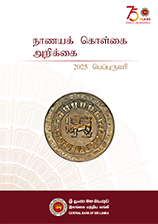The year-on-year growth of broad money (M2b) continued to expand at a high rate of 17.0 per cent in October 2015 compared to 16.0 per cent recorded in the previous month, driven by the expansion of credit extended to both private and public sectors by the banking system. Amongst contributory factors, credit granted to the private sector by commercial banks increased by 26.3 per cent, year-on-year, compared to 22.2 per cent in the previous month. Tentative data for November 2015 also shows that credit flows to the private sector continue to expand at a high rate. Meanwhile, excess liquidity in the domestic money market continues to remain high, fuelling monetary expansion.
Meanwhile, headline inflation, as measured by the Colombo Consumers’ Price Index (CCPI, 2006/2007=100), increased to 3.1 per cent, on a year-on-year basis, in November 2015 from 1.7 per cent in October 2015. On an annual average basis, headline inflation increased to 0.9 per cent in November 2015 compared to 0.7 per cent in the previous month. Following a similar trend, headline inflation based on the National Consumer Price Index (NCPI, 2013=100) also increased to 4.8 per cent, on a year-on-year basis, in November 2015 from 3.0 per cent in October 2015. Reflecting the firming up of aggregate demand conditions in the economy, the CCPI-based core inflation rate registered 4.3 per cent, on a year-on-year basis, in November 2015 vs. 4.4 per cent in the previous month and compared to its recent low of 0.8 per cent in February 2015. Meanwhile, core inflation measures, based on NCPI, also suggest rising underlying inflationary pressures in the economy.
On the external front, the decline in expenditure on imports in October 2015 was greater than the decline in earnings from exports, narrowing the deficit in the trade account by 6.8 per cent, on a year-on-year basis, to US dollars 791 million. However, on a cumulative basis, the trade deficit during the first ten months of the year widened by 2.5 per cent to US dollars 6,936 million reflecting the continued increase in non-oil imports. Meanwhile, earnings from tourism during the first eleven months of 2015 are estimated to have grown by 18.1 per cent, while workers’ remittances grew marginally by 0.8 per cent in the first eleven months of the year. Gross official reserves, which stood at US dollars 6.5 billion at end October 2015, are estimated to have increased to around US dollars 7.3 billion by end November 2015. Reflecting domestic and global developments, the Sri Lanka rupee has depreciated by 8.8 per cent against the US dollar so far in 2015. Notwithstanding these developments, the Monetary Board is of the view that external sector policies already implemented need to be further supported by some monetary policy tightening.
If the current excess liquidity in the domestic money market continues to remain high for an extended period, it could lead to an undue expansion in monetary aggregates, fuelling future inflation in the economy. In that respect, the Monetary Board is of the view that it is appropriate to restrain the build-up of demand-side pressure on inflation to ensure continued monetary and price stability. Accordingly, the Monetary Board decided, at its meeting held on 30 December 2015, to raise the Statutory Reserve Ratio (SRR) applicable to all rupee deposit liabilities of commercial banks by 1.50 percentage points to 7.50 per cent to be effective from the reserve week commencing 16 January 2016. Furthermore, the Monetary Board decided to maintain the Standing Deposit Facility Rate (SDFR) and the Standing Lending Facility Rate (SLFR) of the Central Bank unchanged at their current levels of 6.00 per cent and 7.50 per cent, respectively.
| Monetary Policy Decision: | Policy rates unchanged, SRR increased |
| Standing Deposit Facility Rate (SDFR) | 6.00% |
| Standing Lending Facility Rate (SLFR) | 7.50% |
| Statutory Reserve Ratio (SRR) | 7.50% |










